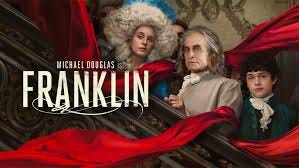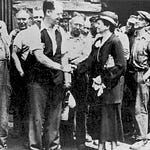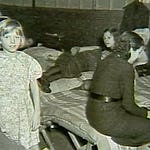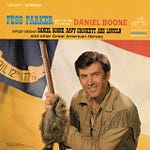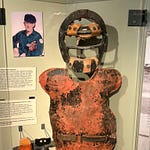Every class I took on the American Revolution focused on the thirteen colonies. In my limited knowledge of the war, the French and Spanish were doing their own things west of the Mississippi, leaving the British-owned but lightly settled Illinois Country in between that saw no real action. I had no idea that the southern part of the old Northwest Territory had been a theater of war until I got a postcard advertising the Filson Historical Society’s Northwest & Indigenous Revolution Tour. It was time to expand my world view from where I’d left it in high school.

Our main tour stops were Fort de Chartres,1 St. Genevieve,2 The St. Charles Heritage Museum,3 The Lewis & Clark Boat House Museum,4 Cahokia Mounds,5 George Rogers Clark National Historical Park,6 and its neighboring site Grouseland7 on the campus of Vincennes University.8
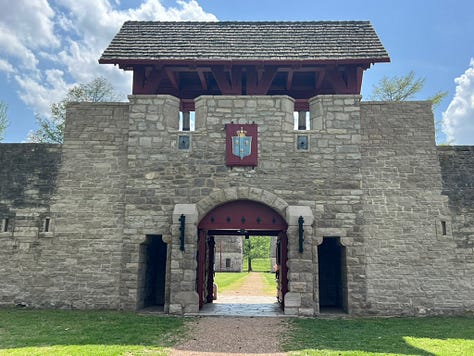
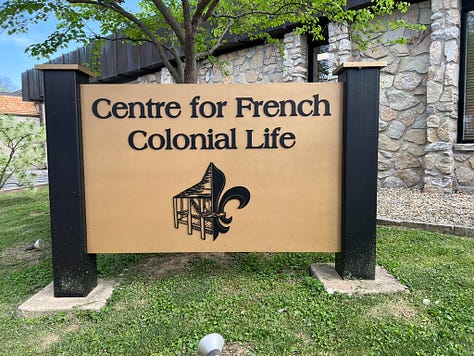
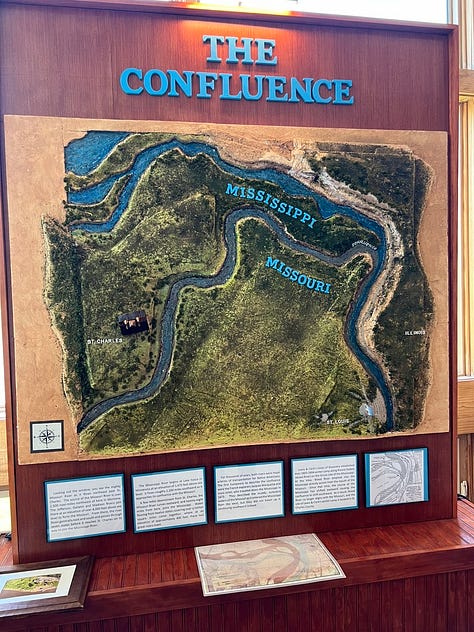
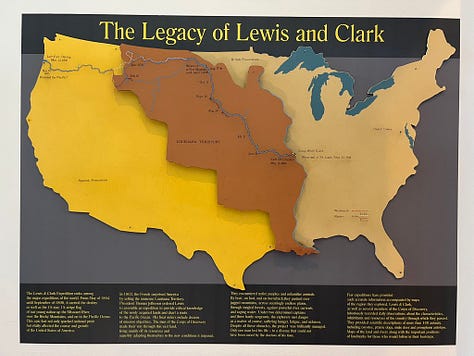
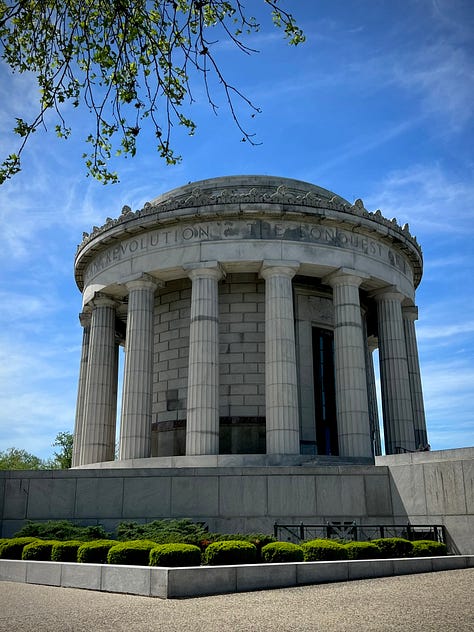
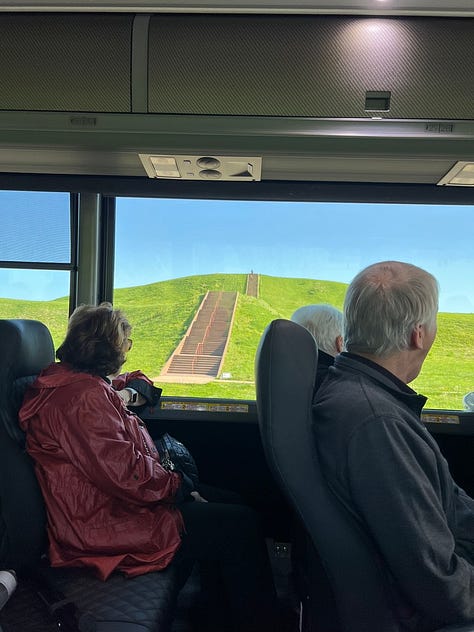
France and Spain in the Revolution
The Bourbon kings of France and Spain were cousins. I would have had to know this to say that I forgot it. The two kingdoms were allied against the British during the Seven Years War, 1756–1763, (we call it the French and Indian War). France was badly beaten by the British during that war, and longed for vengeance. From the Seven Years War to the Revolution, the land west of the Mississippi to the Rocky Mountains, called Louisiana, went back and forth between France and Spain and involved a secret treaty.
Here’s a video to explain how and when it happened. You might have to watch it a couple of times—I did! The way these monarchs played with colonies reminds me of third-graders learning chess moves.
Anyhow, the upshot of all this is that through 1777, France covertly supported the Revolution with guns, weapons, and cash through a shell company (thanks, Ben Franklin!). French volunteers poured into the continent, chief among them Lafayette. After a decisive American win at Saratoga, France formally declared war on England in 1778. Spain joined France as an ally in 1779 without declaring war on England itself. As had happened in the Seven Years War, the clash of empires began spreading across the globe, heavily in the Caribbean, and the British cut their losses in North America.
Speaking of Franklin, I’m enjoying the AppleTV series of that name starring Michael Douglas in the title role.
George Rogers Clark Takes Center Stage
Born near Charlottesville, Virginia, the founder of Louisville, Kentucky, George Rogers Clark played a key role in this story. We talked about him at nearly every stop on our Filson Society tour.
To set the stage for the Illinois theater of war, remember that the Seven Years War included the France relinquishing its Illinois territorial claims to England. At the start of the Revolution, the British relied heavily on native tribes to attack backcountry farms and settlements using guns and ammunition they provided. These attacks had the greatest threats to Virginians in Kentucky County (south of the Ohio River), which the Virginia General Assembly had created 1776. Yes, Kentucky was a Virginia county before it became a state.
At the age of 26, Clark requested and was granted public orders from the governor of Virginia to proceed against the British in the Illinois frontier. He also got a secret commission to launch an attack west into British-held territory. His goal was to seize Detroit, but he started easier targets (see the map above) which had few British forces to defend them.
In his most successful moments he (Clark) crossed over and acted as an Indian war chief: he used their tactics, employed their methods to create group cohesion, shared their sense of honor and justice, terrorized his opponents into believing in his savagery, and even committed what Europeans regarded as atrocities. At the same time, he could put on a uniform and transform himself into a Virginia gentleman. ~National Park Service
With Clark’s victories in hand, after France’s recognition of the new American Republic, the Virginia legislature created the county of Illinois in 1778, comprising all the lands lying west of the Ohio River to which Virginia had any claim.9
Clark’s Legacy: In 1783, the Revolutionary War officially ended with the signing of the Treaty of Paris, and Clark returned to private life. Of importance to The 981 Project was Clark’s role in allotting lands across the Ohio River from Louisville to men who had taken part in his campaigns. He also was appointed a commissioner to make treaties with tribes north of the Ohio River who were continuing their raids into Kentucky.
Fast forward to President Franklin Delano Roosevelt’s dedication of the Clark memorial June 14, 1936. Here’s part of his address:
George Rogers Clark did battle against the tomahawk and the rifle. He saved for us the fair land that lay between the mountains and the Father of Waters.10 His task is not done. Though we fight with weapons unknown to him, it is still our duty to continue the saving of this fair land.
Now, let’s look at Clark in the present moment. An editorial for the campus newspaper, UVA Today, stands in counterpoint to the hero worship formerly bestowed upon Clark:
Clark’s approach to Indian people was Jeffersonian. Jefferson had a scientific fascination with Indian people. But he shared the common view that Indians were a barrier to civilization. During the Revolutionary War, Jefferson…wrote (to Clark) that the best way to deal with Native people was “total suppression of Savage Insolence and Cruelties.”
Clark followed Jefferson’s advice frequently following attacks on Shawnee villages, for instance, with the destruction of their houses and crops. His dealings with the Shawnees at the negotiations over the Treaty of Fort McIntosh in 1785—which the Shawnee rejected—further inflamed American relations with Native people and prolonged military conflict. No conquering occurred.
~Christian McMillen, UVA associate dean for the social sciences and professor of history
Indeed, Clark’s star has tarnished, mostly because our country is reckoning with the legacy of “white men as conquerors and empire builders.” His monument on the campus of UVA calls him the “Conqueror of the Northwest” and it features Indian people braced for violence—possibly murder. It has been removed with the approval of the Board of Visitors.
Guy Lopez, a co-founder of the Native American and Indigenous Studies (NAIS) at UVA, described seeing photos of the statue come down as “bittersweet.” Lopez had long advocated for its removal, but he also wishes the $400,000 bill to remove the monument could have been used to fund NAIS programs. His final point landed pretty hard with me: the Clark statue was the only public, large-scale depiction of Native Americans at UVA.
I’ve tried to give a broad view of history here, and to acknowledge our current struggle to interpret, celebrate, and sometimes shun historical figures. As always, I welcome all civil comments and invite you to share this with someone who might find it interesting.
I’ll be back with May Trivia mid-month.
Fort de Chartres served as the French seat of government and its chief military installation in Upper Louisiana from 1753 until 1765 when it was occupied by the British. In 1763, France ceded much of its territory in North America, including what is now Illinois, to Great Britain.
Missouri’s oldest permanent European settlement, the village of Ste. Geneviève was settled by French Canadians around 1735 on the west bank of the Mississippi River about two miles south of its present location. In 1763, after the French and Indian War ended, France ceded all of its holdings west of the Mississippi River to Spain.
We loved the St. Charles County Heritage Museum’s new exhibit: The American Revolutionary War in the West. That evening, we had the pleasure of a dinner presentation by the co-curator of the exhibit, author Stephen L. Kling, Jr.
The Lewis and Clark Boat House and Museum features full-size operational replicas of the boats used by Lewis & Clark. On the second floor we explored displays focused on the expedition and the Filson Society arranged a private lecture for our group on all things Lewis & Clark.
The remains of the most sophisticated prehistoric native civilization north of Mexico are preserved at Cahokia Mounds State Historic Site. Within the 2,200-acre tract, located a few miles west of Collinsville, Illinois, lie the archaeological remnants of the central section of the ancient settlement that is today known as Cahokia.
The monument is located at Fort Sackville, a former British outpost located in the frontier settlement of Vincennes. On Feb. 25, 1779, the garrison surrendered to American Colonel George Rogers Clark.
William Henry Harrison built this mansion along the Wabash River in Vincennes, Indiana, in1802-1804. He intended it to be the center for the Territorial government, his family home and a fortress of protection during hostile times.
Founded in 1801 Vincennes University is Indiana’s first college.
The mountains are the Appalachians and the Father of Waters is the Mississippi



